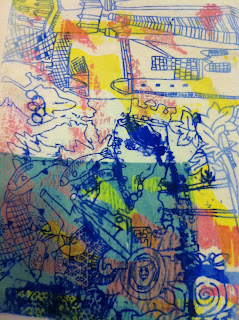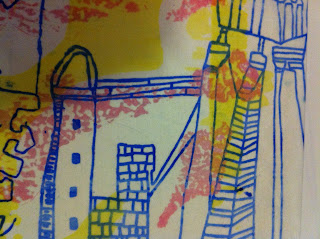Shopping, Women and the City 27.1.12
The Flaneur is a gentleman stroller who walks the streets and aracades of the city looking in shop windows, other people in the streets stare at him. The Flaneur is mentioned in many writings, in books. However there is no mention of a female flaneur, a flanette. Women werent excluded from partcipation in the modern city they were just excluded from the texts which represented it. They had to be chaperoned if they were to walk the streets by their husband, brother or father, otherwise a lady not accominied by a chaperone was labeled a prostitute. Working class women walked alone, this you could tell by their clothes if they were a washer women or had a job in that area. Ballet dancers walked alone and this was classified as working clas, however nowadays they are classified as dancers who are immensly talented and treated with respect. Womens pressence in the 19th century could be uncompanied by their chaperone if they were going to a teadroom, gallery or museum these were public places seemed decent enough for upper class women alone.
Nowadays urban life has a fixed price tae, you used to be able to just go into the city and window shop, become a flaneur, but nowadays you cant not spend money, whether its on a train fare a bottle of water. Citys nowadays arent places to stand and look or talk, they are all about movement, there arent many places to sit in coffee shops as your not ment to, its a quick coffee or lunch then on the move again. When the department store came along citys became part of consumption not a place to make things anymore. By the end of the 19th century most cities had a department store, and these were used for rational as they were moving forwards. They are now also or entertainment, exhibtions, museums cinemas.
The first french department store was called the Bon Marche and it opened in 1850, it was the first time shoppers could walk around and browse it became fun. Consumption was becoming easier to do, its now even more easier in the 21st century as you can stay inside and do it all on your computer.
There was a difference between a fancy goods store and a department store as the fancy goods store wasnt as high a quailty as the department store is. A fancy goods store there were no foxed prices, as you were given a price on the way you looked, so if an upper class household sent their maid they would it at a cheaper price.
The department store had a returns policy so the women would buy all these goods and show their husbands who would say its to much money the wife would say theres a returns policy, but the husband would rather the goods then the embarresment of returning as the returns deask woudl be in the middle of the store and eveyone would see as these days a department store was every open with glass pannels, two floors with balconeys so you could see what other women were buying and spending, so everyone would be able to see if you were returning goods and this was humiliation. The peolpe behind the returns desk were men and they would be rude to the women about returning goods and make them feel small. All of this was a poly to make them keep the item, it was easier to keep it then return the goods, this was consumption by the department store. The departement stores were built in circles, so everyone could see you, so you werent sure if you were being spyed on or not. It was a panoctium, there were guards looking at you, like there are sucurity men in the 21st century.
Rationalisation was happening to citys as they were expanding, they were being rebuilt bit by bit, side walks were getting bigger so it ment the shop windows were getting bigger so peolpe could stop and look and see what was infront of them. Peolpe looked for a long time as it gave them the feeling that they had actually bought the goods by looking at them so much in such depth because the windows were so big. Department stores where all about getting everything and anything in a shop window to make to the store look very grand, it was showing modernity showing what they could make and that life was getting better. The rationalism of citys ebign rebulit made them become on a grid system of streets and roads, which made it easier for everyone to get around and it made it easier of women to egt to the shops and you could find your way easily.
Cystyal palace was a department store on a grand level, it was in the city yet everything to make the palace was made around the country, the steel the glass and it was brought to the sity like flat pack to be made. Cystal palace was very grand with open spaces, fabric drapped over the balconeys, it had a glass roof so light could come in, it was a very feminine space.
Transport was becoming better, we were designing ocean liners with class as they had the grand stairways and balconeys with drapped fabric like the department stores did, titantic was one of these. Chandielers, carpets wooden floors, it oozed luxjaurity.
Women were wearing crinilin cages underneath their dresses to make them have these big posh looking skirts and corests which wer very uncomfortable so there were velvet sofas they could rest on. Department stores had toliets for women to use, so it ment they coul spend the whole day shopping without having the need to go home, they could refeshen up whilest shopping.
The department stores couldnt have working class girls working on the shop floors, it gave the wrong impression, so they ahd to have middle class women but not married ones either. However it was difficult as middle class girls couldnt get the train in on their own, so they would live in the department store. A lot of deaths happened here due to the stores having a lot of lighting with oil lamps, a lot of fires happened so a lot of deaths occured. If you were a gay women working in the department store was a good job as it wouldnt be suspected that you were gay due to the place you worked, so you could slip under the radar. Men started to worry about their wives shopping so much because of frotteurs, who were men who rubbed themselves against women, but actually they would be rubbing against the crinilin cages.
Men think they own the city and dont want women taking over so to do their shopping they had their own entrances to the department stores, their own shop assistents, so they could be serperate to women. Women were told not to travel to shop in rush over as men didnt want to be around women with shopping bags and talking about fashion and furnishings.
Brent cross was out first out of town shopping mall built in 1976, a concept imported from america. These were covered by roofs with no light, so you couldnt know what time of day it was so you could shop all day without realising. Shopping nowadays is more then just spending money its the thought of getting a bit of culture too but the status and marble floors malls have nowadays.
Women could get away with theft by the fact they were women, they were seen as weak so woudlnt steal.
Seminar 2
The media dont tell you the full story, they crop out half the image and dont tell you whats happening to the right hand side of the amry soldiers. It all depended what TV chanell you were watching whether the amry were heros or muderers? Context is always neccassery for image analyse.
Media images never tell you the truth, whether its airbrush or the photos been cropped. But how often do we question an image? Rarely.
Perspection changes through images and through the years also, as style changes so the images change also. Commerical images are expensive to make so if its in the image its there for a reason.
Richard Dyer says that representation is culture, specfic representations are presentations.
The media tells the truth as this is what this culture agrees with as they went through advertising analysis to show this so its culturely acceptable.
Seminar 2



















































